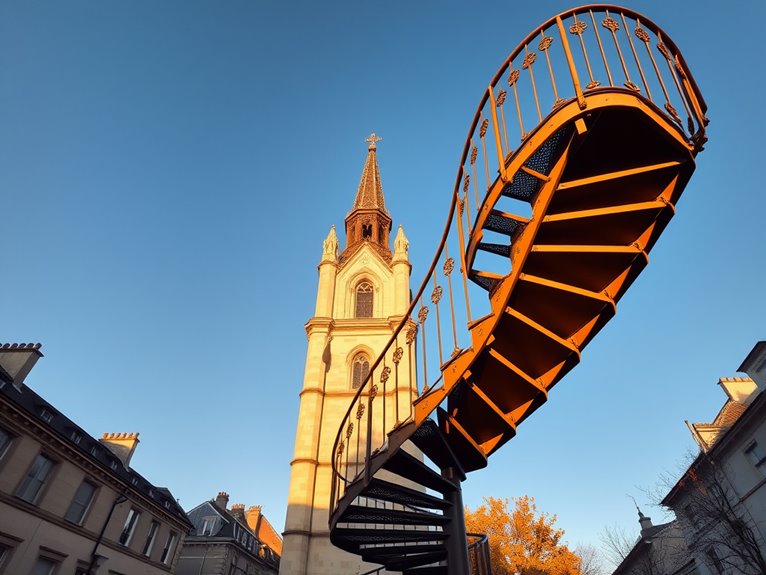
6 Unique Parisian Towers With Fewer Tourists
Looking to escape the Eiffel Tower crowds? I've got six amazing alternatives! Check out the Gothic Tour Saint-Jacques with its stunning 52-meter views, or head to Montparnasse Tower's spacious observation deck. Don't miss Tour Jean-sans-Peur's medieval charm, the modern glass towers of Bibliothèque Nationale, Saint-Sulpice's mismatched twins, or Tour De L'Horloge's ancient astronomical clock. Each tower offers unique perspectives and photo ops that most tourists haven't discovered yet. Let's explore these hidden architectural gems together!
Tour Saint-Jacques: A Gothic Masterpiece in the Marais
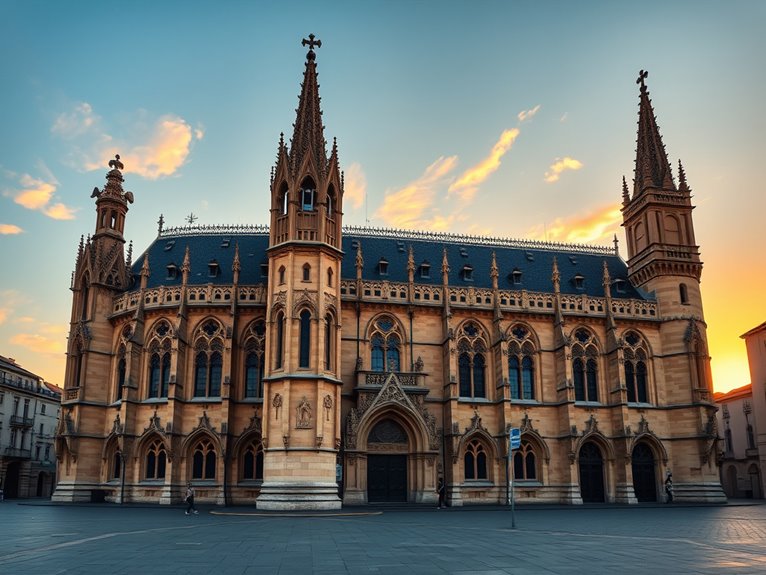
Towering above the bustling streets of Le Marais, the Tour Saint-Jacques stands as one of Paris's most striking examples of flamboyant Gothic architecture. This 16th-century bell tower, the sole remnant of the former Church of Saint-Jacques-de-la-Boucherie, rises 52 meters into the Parisian skyline, offering visitors a remarkable glimpse into medieval French craftsmanship and religious history.
Once a vital waypoint for pilgrims traveling the Santiago de Compostela route, today the Tour Saint-Jacques serves as both a historical monument and an unexpected urban oasis, surrounded by a charming square and manicured gardens. Its intricate stone carvings, gargoyles, and statues tell stories of religious devotion, while its recent restoration has breathed new life into this architectural masterpiece.
Quick Facts:
- Opening Hours: July-September, Friday-Sunday only
- Guided Tour Cost: €10-15 per person
- Visit Duration: 45-60 minutes
- Maximum Group Size: 17 people
- Photography: Allowed, tripods permitted
- Best Time: Early morning for ideal lighting
- Accessibility: 300 steps, no elevator
- Location: Square de la Tour Saint-Jacques, 4th arrondissement
The Tower Experience:
The Tour Saint-Jacques offers limited guided tours that take visitors up the narrow spiral staircase to reach the observation platform. The ascent reveals magnificent views of central Paris, including Notre-Dame, the Centre Pompidou, and the Seine River. Insider tip: Book tours at least two weeks in advance through the Paris City Hall website, as spots fill quickly during the short summer season.
The Gardens:
The surrounding square features meticulously maintained gardens perfect for picnics or peaceful breaks from city exploration. The park benches offer excellent vantage points for architectural photography, particularly during golden hour. Lesser-known fact: The garden's layout was designed to mirror the floor plan of the original church.
The Architecture:
The tower's elaborate decoration includes statues of saints, mythological creatures, and symbolic animals. Most notable is the statue of Saint Jacques himself at the tower's summit, accompanied by symbols of the four evangelists at each corner. Hidden detail: Look for the salamander motif, emblematic of King François I, subtly carved into various sections of the tower.
Pro Tips:
The best time to photograph the tower is during the "blue hour" just before sunset when the stone takes on a golden glow and the surrounding modern buildings fade into the darkening sky. For the guided tower climb, wear comfortable shoes and bring a water bottle – the spiral staircase can be challenging, but the guide will make several stops to share historical insights and allow for rest.
Practical Advice:
Reserve your tour spot in advance and arrive 15 minutes early for security checks. Consider visiting the nearby BHV department store or Marais district afterward, as the tower's limited opening hours make it ideal to combine with other attractions. Weather conditions can affect tower access, so have a backup plan and check the forecast before your scheduled visit.
Montparnasse Tower's Sky-High Observation Deck
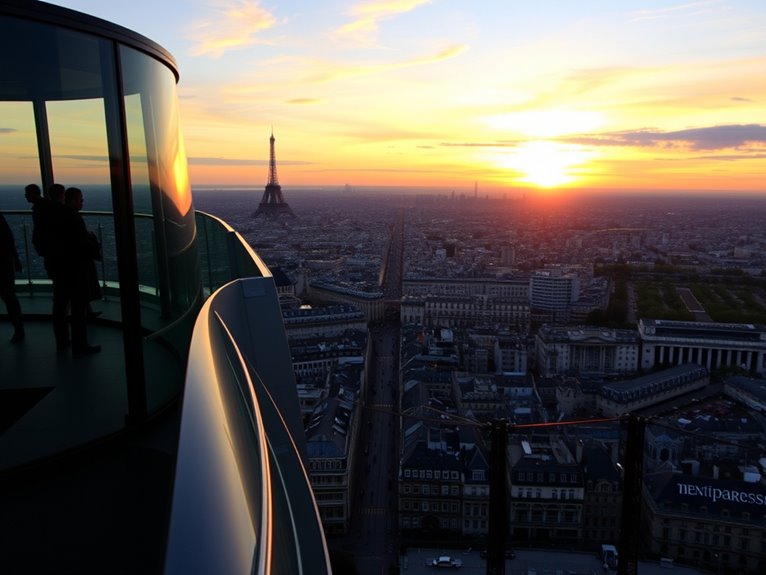
Standing at 210 meters (689 feet), the Montparnasse Tower's observation deck offers what many consider the best panoramic view of Paris. Unlike its more famous counterpart, the Eiffel Tower, this vantage point actually includes Paris's iconic iron lady in its spectacular cityscape, making it a photographer's dream location for capturing the essence of the City of Light.
The 56th and 59th floors of Tour Montparnasse provide visitors with both an indoor viewing gallery and an open-air terrace, offering 360-degree views of the French capital. On clear days, visibility extends up to 40 kilometers, allowing visitors to spot landmarks like Notre-Dame, Sacré-Cœur, and the Arc de Triomphe while enjoying a less crowded, more relaxed viewing experience than other elevated Paris attractions.
Quick Facts:
- Opening Hours: 9:30 AM – 10:30 PM (11:30 PM in summer)
- Admission: €18 for adults, €15 for students, €9.50 for children (4-11)
- Best Visiting Times: Sunset and first hour after opening
- Photography: Tripods allowed during specific hours
- Average Visit Duration: 30-60 minutes
- Elevator Speed: 38 seconds to reach the top
- Weather Consideration: Indoor viewing area available during inclement weather
The 56th Floor Observation Deck features floor-to-ceiling windows providing unobstructed views in all directions. Interactive touchscreens help visitors identify landmarks and learn about Paris's history. The space includes a champagne bar and restaurant, perfect for special occasions. Insider tip: Book a sunset reservation at the restaurant to skip the regular admission queue.
The 59th Floor Open-Air Terrace offers the highest rooftop terrace in Paris. Recently renovated with modern safety features, it includes specialized viewing binoculars and information panels. Unlike other observation decks, photographers can use professional equipment here without special permits. Lesser-known fact: Early morning visits often reveal a stunning layer of fog below, creating magical photo opportunities.
Pro Tips:
Visit during "blue hour" (just after sunset) when Paris lights begin twinkling but there's still enough natural light to capture both day and night shots. Consider purchasing the "Day & Night" ticket, which allows two visits within 48 hours – one during daylight and one after dark. For the best experience, check weather forecasts and avoid cloudy or rainy days, as visibility can be considerably reduced.
Practical Advice:
Book tickets online in advance to save time and money. The entrance is located at 33 Avenue du Maine, accessible via Metro lines 4, 6, 12, and 13 at Montparnasse-Bienvenüe station. Visitors with Paris Museum Pass should note that the observation deck is not included in the pass. Consider combining your visit with exploration of the Montparnasse neighborhood's famous cafés and art galleries, all within walking distance of the tower.
The Medieval Charm of Tour Jean-sans-Peur
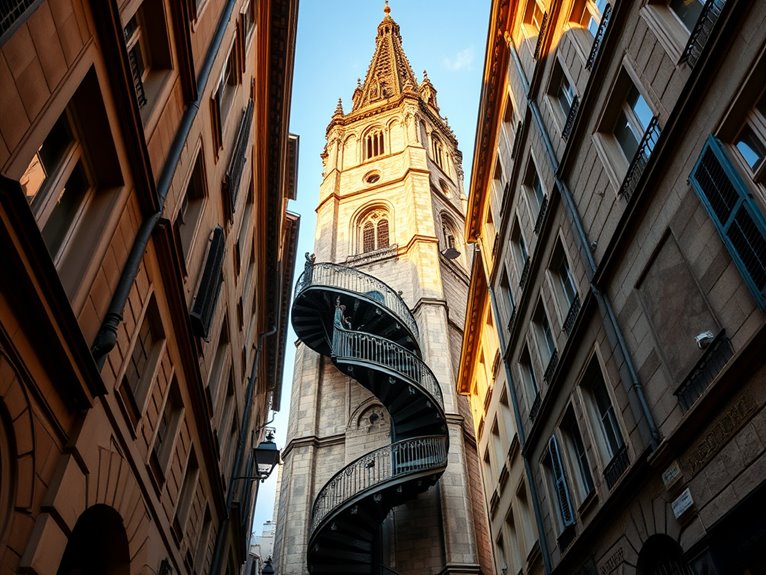
Standing proudly in Paris's 2nd arrondissement, the Tour Jean-sans-Peur (John the Fearless Tower) represents one of the city's most exceptional pieces of medieval architecture. Built between 1409 and 1411, this fortified tower served as part of the residence of the powerful Dukes of Burgundy, offering modern visitors a rare glimpse into medieval Parisian life and architecture.
As the last remaining vestige of the Dukes' grand palace, the tower showcases extraordinary Gothic architectural elements, including an innovative spiral staircase adorned with intricate sculptural decorations depicting the growth of plants throughout the seasons. The tower's historical significance extends beyond its architectural merit, as it played a vital role in the political intrigues of 15th-century France, particularly during the bitter rivalry between the Burgundians and Armagnacs.
Quick Facts:
- Opening Hours: Wednesday to Sunday, 1:30 PM – 6:00 PM
- Admission: €6 for adults, €3 for reduced rate, free for children under 18
- Best Time to Visit: Weekday afternoons for fewer crowds
- Photography: Allowed without flash; tripods require permission
- Accessibility: Limited, spiral staircase access only
- Languages: Information panels in French and English
- Guided Tours: Available on weekends (reservation required)
The Gothic Staircase
The tower's crowning glory is its striking spiral staircase, featuring one of the earliest examples of stereotomic innovation in French architecture. The staircase winds its way up through six floors, with each level offering unique sculptural details representing different aspects of medieval life. The plant-growth sculptures are particularly remarkable, serving as both decoration and a medieval calendar.
The Duke's Chamber
Located on the third floor, the Duke's Chamber provides insight into medieval noble living quarters. The room features original 15th-century architectural elements, including period-accurate furniture reproductions and interactive displays explaining daily life in medieval Paris. The chamber's arrow slits and defensive features remind visitors of the tower's protective purpose.
Medieval Garden Exhibition
The ground floor houses a permanent exhibition about medieval gardens and their importance in daily life. The display includes detailed information about medicinal herbs, food cultivation, and the symbolic meaning of various plants in medieval culture. Interactive elements allow visitors to experience the scents and textures of common medieval garden plants.
Pro Tips:
Time your visit for late afternoon when the sun's position creates dramatic lighting effects through the tower's narrow windows, perfect for photography. The best views of the spiral staircase's sculptural details are found by climbing slowly and using a small flashlight to illuminate the carvings. Consider visiting during the tower's special evening events, held several times yearly, which feature medieval music and period-costumed guides.
Practical Advice:
Wear comfortable, flat shoes as the spiral staircase can be challenging to navigate. Visit the tower as part of a larger exploration of medieval Paris, combining it with nearby sites like the Museum of Middle Ages (Cluny Museum) and Saint-Germain-l'Auxerrois church. Purchase tickets online to avoid queues, and download the tower's free audio guide app before your visit for enhanced understanding of the historical context and architectural details.
Bibliothèque Nationale's Four Glass Towers
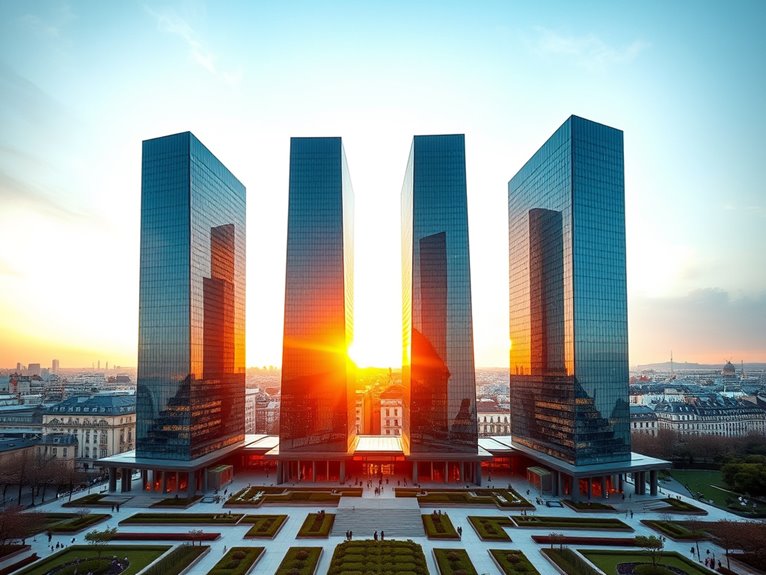
The Bibliothèque nationale de France (BnF), crowned by its distinctive four glass towers, stands as one of Paris's most striking modern architectural achievements. Designed by architect Dominique Perrault and completed in 1995, these L-shaped towers represent the open books of knowledge, rising 79 meters into the Parisian skyline like crystalline sentinels guarding France's literary heritage.
These impressive structures do more than simply house books – they represent a bold architectural statement about the role of knowledge in modern society. Each tower, named after a different literary figure, contains 22 levels of books and manuscripts, while their unique design allows natural light to filter through while protecting the precious contents from direct sunlight through an innovative system of wooden shutters and filtered glass.
Quick Facts:
- Opening Hours: 10:00 AM – 8:00 PM (Tuesday-Saturday)
- Admission: €15 for adults, free for students and under 18
- Photography: Allowed in public areas, no flash in reading rooms
- Best Visiting Time: Weekday mornings for fewer crowds
- Accessibility: Full elevator access to all levels
- Guided Tours: Available in multiple languages (booking required)
Tower Northwest (Tower des Temps):
Dedicated to philosophy and religion, this tower offers panoramic views of the Seine. Its upper floors house rare manuscripts and feature specialized reading rooms for researchers. The tower's unique positioning captures morning light, creating stunning reflections across the library's central garden.
Insider Tip: Visit the 18th floor for the best sunset views over Paris.
Tower Northeast (Tower des Lois):
Housing law and economics collections, this tower features innovative mobile shelving systems that maximize storage space. The ground floor hosts rotating exhibitions highlighting legal documents from different periods.
Insider Tip: Check the monthly calendar for special evening lectures in the ground-floor auditorium.
Tower Southeast (Tower des Nombres):
Focusing on science and technology, this tower incorporates advanced climate control systems to protect sensitive materials. Its design includes specialized rooms for digital preservation projects.
Insider Tip: The 15th-floor reading room offers the quietest study space and best views of the garden.
Tower Southwest (Tower des Lettres):
Dedicated to literature and the arts, this tower contains the library's most extensive collection of rare books. Its modern conservation laboratory is occasionally open for public viewing.
Insider Tip: Book a conservation workshop tour three months in advance for behind-the-scenes access.
Pro Tips:
The towers are best photographed during the "golden hour" just before sunset when the glass facades create spectacular light effects. For the most rewarding visit, combine tower exploration with time in the central garden, where the sunken design creates a peaceful oasis surrounded by the towers' reflective surfaces. Consider purchasing an annual pass if planning multiple visits, as it includes priority access and special exhibition previews.
Practical Advice:
Visitors should register for a reader's card online before arrival to save time. The library's location in the 13th arrondissement means it's less crowded than central Paris attractions, but the surrounding area offers limited dining options – pack a lunch or plan to eat at the library's café. The best metro access is via line 14 to Bibliothèque François Mitterrand station, with direct connections to central Paris.
Saint-Sulpice Church's Twin Towers
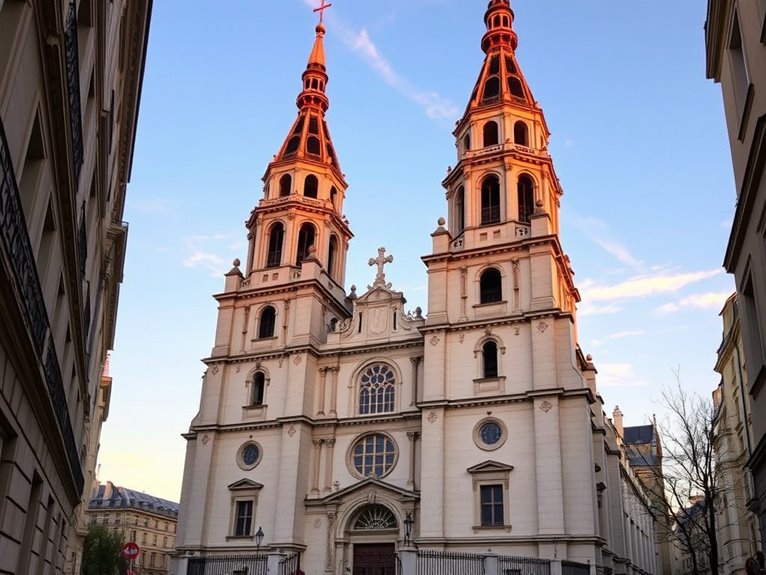
The Contrasting Towers of Saint-Sulpice
——————
The twin towers of Saint-Sulpice Church stand as distinctive landmarks in Paris's 6th arrondissement, though their mismatched appearance tells a fascinating story of architectural evolution and historical circumstance. Built in the 18th century, these towers represent one of the most intriguing architectural anomalies in Paris, with one tower standing noticeably taller than its counterpart, creating an asymmetrical facade that has captivated visitors for centuries.
What makes these towers particularly remarkable is their role in both religious and cultural history. The incomplete nature of the north tower, left unfinished due to financial constraints during the French Revolution, has become a defining characteristic of the church's appearance. This architectural quirk, combined with the towers' prominence in literature (notably in Dan Brown's "The Da Vinci Code"), has transformed them into must-see landmarks for architecture enthusiasts and cultural tourists alike.
Quick Facts:
- Best visiting hours: 7:30 AM – 7:30 PM (daily)
- Photography allowed: Yes (no flash during services)
- Admission: Free
- Best viewing time: Late afternoon for ideal lighting
- Tower height difference: 5 meters between north and south towers
- Architectural style: Classical French Gothic
- Location: Place Saint-Sulpice, 6th arrondissement
The South Tower
The completed south tower reaches a height of 73 meters and features intricate classical detailing characteristic of French Gothic architecture. Visitors can admire its perfectly proportioned design, complete with Doric and Ionic columns. The tower houses part of the church's impressive bell system and offers stunning views of Luxembourg Gardens from certain vantage points in the neighborhood. Insider tip: The best photos of the south tower can be captured from the café terraces on Rue Férou.
The North Tower
Standing at 68 meters, the unfinished north tower tells a compelling story of historical upheaval. Its incomplete state resulted from the French Revolution's interruption of construction in 1777. The tower's "unfinished" appearance has become a cherished characteristic, showcasing raw stone and creating an interesting contrast with its completed sister tower. Little-known fact: Local artisans still occasionally work on the tower's preservation, using traditional 18th-century techniques.
Pro Tips:
For the most rewarding visit to Saint-Sulpice's towers, time your arrival for late afternoon when the sun's position creates dramatic shadows across the facade. Photographers should position themselves in the square directly in front of the church during the golden hour (approximately one hour before sunset) for the best lighting conditions. Additionally, visiting during weekday mornings offers the quietest atmosphere for contemplation and unobstructed views.
Practical Considerations:
While the towers themselves cannot be climbed by visitors, the church offers guided tours that provide detailed historical information about their construction and significance. Book these tours at least one day in advance through the church office, and bring binoculars if you're interested in studying the architectural details up close. The square in front of the church provides excellent viewing opportunities and is wheelchair accessible.
The Hidden Splendor of Tour De L'horloge
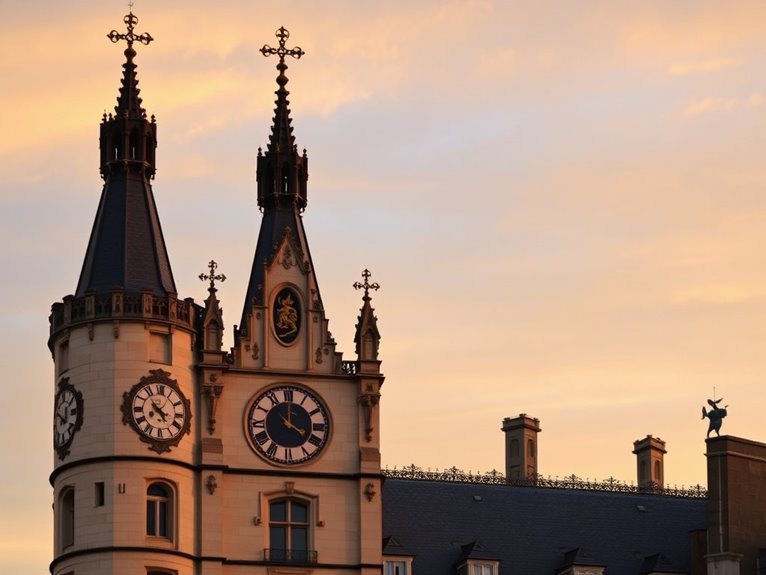
Nestled in the heart of Paris's 1st arrondissement, the Tour de l'Horloge (Clock Tower) stands as a magnificent representation of medieval French architecture and timekeeping innovation. This 14th-century masterpiece, attached to the Conciergerie, has witnessed centuries of Parisian history while maintaining its role as one of the city's most significant historical timepieces.
Originally commissioned by King Charles V in 1370, the tower represents more than just a timekeeper – it symbolizes the modernization of medieval Paris and the power of the French monarchy. The tower's intricate astronomical clock, added in 1370 and restored several times throughout history, continues to captivate visitors with its ornate decorations and mechanical precision.
Quick Facts:
- Best visiting hours: 9:30 AM – 6:00 PM (April-September); 9:00 AM – 5:00 PM (October-March)
- Entry fee: Included with Conciergerie ticket (€9.50 for adults)
- Photography: Allowed without flash; best light for photos in early morning
- Accessibility: Limited, stairs only
- Duration: 30-45 minutes for thorough viewing
- Location: 2 Boulevard du Palais, 75001 Paris
The Clock Mechanism
The tower's crowning glory is its extraordinary clock mechanism, featuring both civil and astronomical timekeeping. The original mechanism, though modified over centuries, represents one of the oldest public clocks in Europe. The clock face displays traditional time, lunar phases, and zodiacal symbols, all decorated with gilded elements that shine brilliantly in sunlight. Insider tip: Visit during the quarter-hour marks to witness the angel figurines in motion.
Architectural Details
The Gothic architecture of the tower showcases intricate stonework, gargoyles, and sculptural elements that exemplify French medieval craftsmanship. The tower's corner turrets and pointed roof create a distinctive silhouette against the Parisian skyline. The recent restoration work completed in 2012 revealed original paint colors and architectural details previously hidden beneath centuries of grime.
Historical Significance
Beyond its timekeeping function, the tower served as a symbol of royal justice, as it overlooked the medieval court of the Conciergerie. The clock's reliability made it the official timekeeper for the entire city, regulating everything from market hours to court sessions. Lesser-known fact: The tower contains a small chamber that once housed the clockmaster, who maintained the mechanism daily.
Pro Tips:
For the most memorable experience, visit during the first hour after opening when crowds are minimal and morning light illuminates the clock face perfectly. Combine your visit with a tour of the Conciergerie for an exhaustive understanding of medieval Paris. Professional photographers should bring a zoom lens to capture the intricate details of the clock face and sculptures from street level.
Practical Advice:
Reserve tickets online to avoid queues, especially during peak tourist season (June-August). The surrounding area offers limited parking, so arrive via Metro (station: Cité) or RER (station: Saint-Michel Notre-Dame). Consider booking a guided tour that includes both the tower and the Conciergerie to maximize historical context and access to areas not open to the general public.
